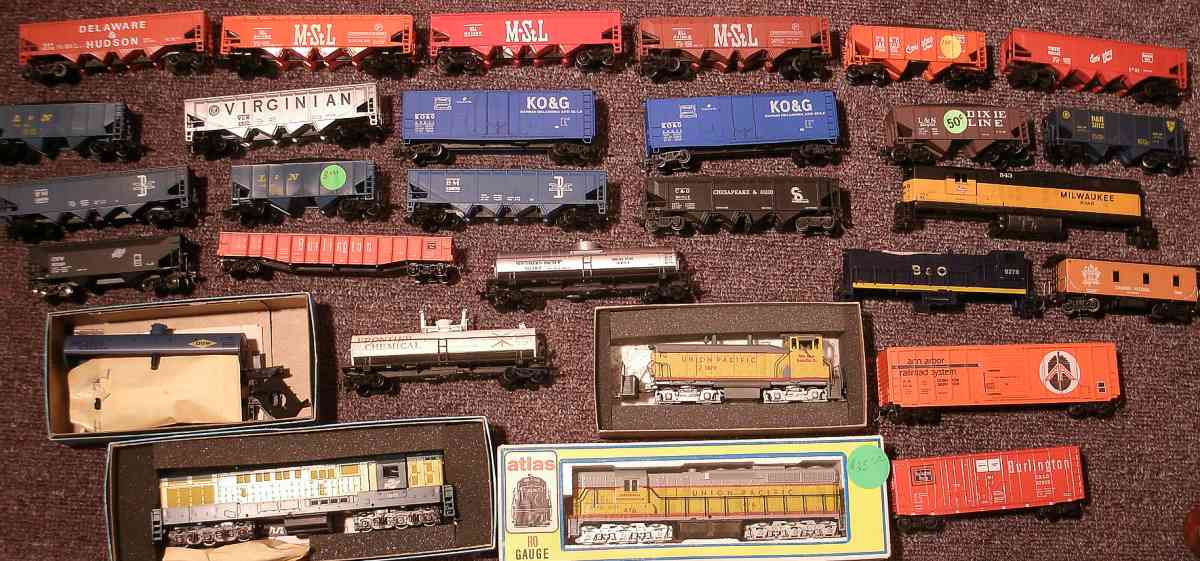
|
I got to the Artic Run model railroad show in Stevens Point. For an hour while Jon was there, I rushed through the vendor tables and bought one bag of used train cars. And 4 hours later, just as the show ended, I was back again and bought 3 more bags.
For $3 a car, I doubled my fleet of red quad hoppers that are fallen flags railroads. .
I will have to be more careful of the quality of cars I buy.
One big thing I noticed afterwards is the interior of the toy car is red, like the outside. |
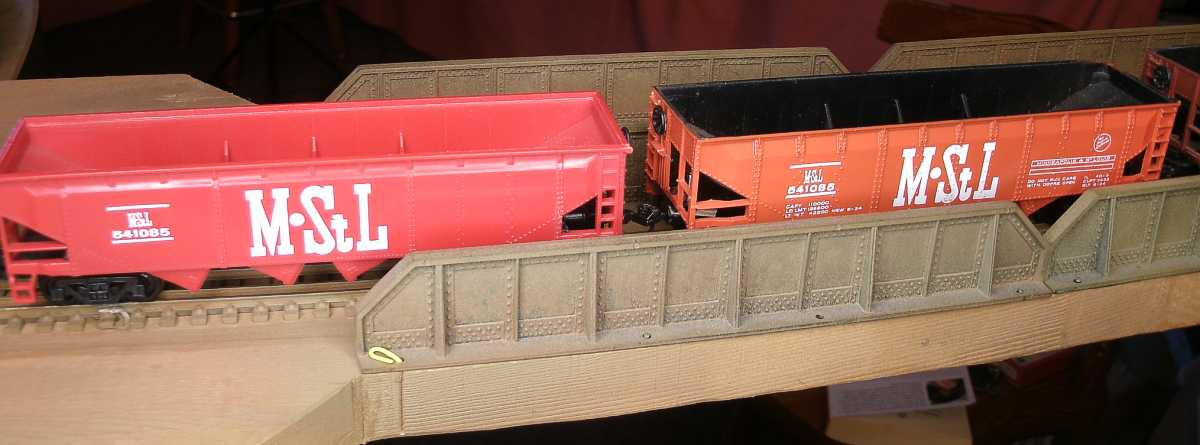
.
|
Going back to the picture at the top of my page, I tripled my roster of Kansas Oklahoma and Gulf blue plugdoor boxcars, The last time I got one was in the 1960's.
I did play $6 for a CNW brown hopper with Kadee couplers and metal wheels,
Jon, that's a Baldwin loco shell ($2) with B and O letters on a blue body, |
|
I bought something that at first I probably shouldn't have, a UP Athearn SW 1500 with a metal Cary Locomotive Works shell. But the price ($15) was right to attempt repairs It was known to have been dropped, maybe by a little boy who didn't realize how heavy this thing is. The shell weighs 14 oz. and the motor and frame is 8; that's way over a pound for such a small locomotive. I took it apart and see it had a can motor taped in place of the original Athearn motor. It howled at speed. I suspect it has ball bearings in it. So, I oiled the motor shaft and let it soak in, and the next day it ran 10 feet and the howl came back. And oiled it again the next day, the same results. And the next. And I learned the noise went away when I turned the unit up-side down on my wheel cleaner rack And I oiled the noisy end of the motor once more, and it has run good and quiet since.
The entire 'front porch' was broken off from the fall, that's diecast zinc, and I epoxied it back on.
But there's lots of nice details and wire handgrabs and even an armrest on that Cary shell.
|
|
On the lower left of the picture is an Athearn CNW Trainmaster, new in the original box with handrails still in the package, $25. this loco was $22.75 'back in the day'. The wheels sparked while running on brass track, but I was able to clean it up. Runs good with my two other old Trainmasters, and all 3 are of the same age. I also just remembered that Athearn metal frames are 'hot' live electrically from one rail. I usually drill and tap and screw on the Kadee plastic draft gear boxes to locomotives, so they are totally electrically insulated. But I never did that to my original TrainMasters, I just used the plastic U-clip, which means a coupler could short through to the next locomotive if it has the same coupler installation AND if one locomotive is run facing the other direction. Which might explain why my TrainMasters sometimes 'dogged down'. Now that I have 3, I am fixing all of them with plastic coupler boxes so I don't have to be fussy about how to M. U. them. .
|
|
The Atlas SD-24 ($25) is interesting, I always like small SD-s. This one even runs on my 15-inch radius (HO scale). The label on the box said it runs good, but that late in the show I had no way to test run it. At home, it has a ticking noise, probably from an axle gear, when it is running in reverse. So, never believe how someone labels a box. That's the second time in a year that I didn't learn that lesson.
I have other UP loco's to double head it with that can speed match with it, |
You might recall after the last train show that I said I would be more particular about the used locomotives that I buy.
And that I really didn't need much more hp for my size of railroad.
Oh Well, maybe I will remember that at the next train show.
Whcih reminds me of a statement by another model railroader:
|
Am beginning to believe this RR thing can become addictive
. wrote by John B of Nebraska.in June, 2002 in an old Yahoo rail group |
The Ann Arbor Ferry in the Fog car turns out to be the most interesting,
and in the future I will make a web page about it and my other Ferry car, and the ferry.
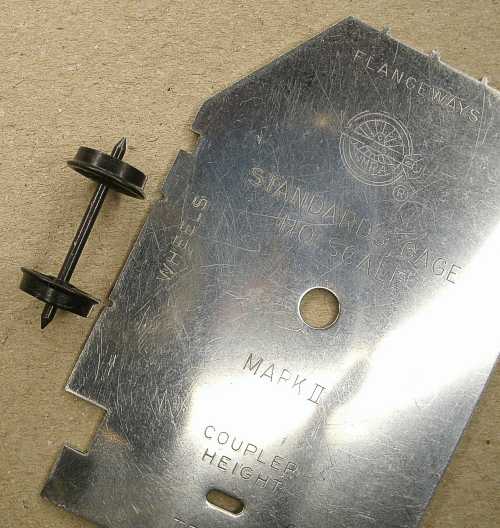 .
.
Buying those $3 'wonders' (one was even 50 cents) has gotten me car models that are not always available,
but still have just good enough wheels and trucks.
About a third of the better (but still used) $6 and even $12 cars that I have bought have poor wheel gauge.
I wonder how many people sell a good modern expensive (over $20 when new) car because it derails,
instead of checking into why.
I've seen people add weight to cars to keep them on the rails,
but in my opinion, weight just increases the crash effect during a derailment.
That's a 40-year old NMRA gauge, still works great.
Those wheels were over 1/16 inch too close together.
I will be more careful to buy 'junk' cars that at least have wheels that roll freely.
It's bad enough that I put Kadee couplers on old cars and double their cost,
and I sure don't want to replace trucks.
One small advantage of those cars is they are light, so my locomotives can lug them up the hills on my railroad.
I like my burgeoning fleet of 34-foot Greenville Car Company twin bay coal hoppers.
Their capacity is only 50 tons (no wonder they have all disappeared from real railroads)
but that short length looks good on trains snaking around sharp curves.
I wondered what made one so heavy, and I was able to pop off the coal load and
SURPRISE someone put in small rocks (not ballast) and held it there with white glue.
Look, it's a Varney from a 1959 mold. I have a few of those.
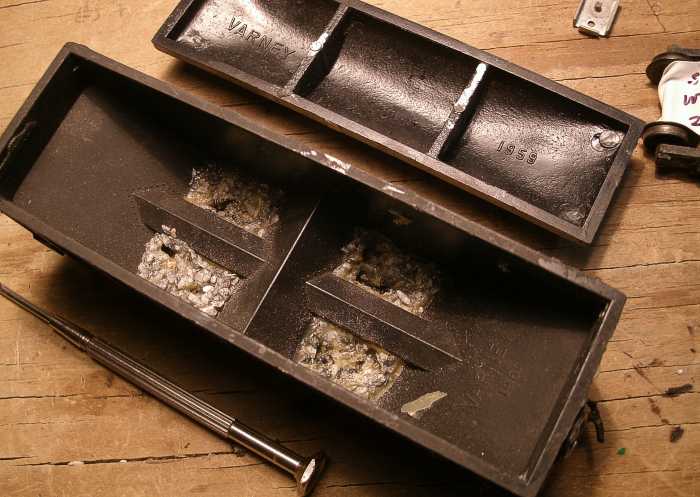
|
And sometimes there is an unexpected surprise with old cars, even when they are of 'high quality' and cost a bit. I still run my Ernst geared locomotives, when I want to set the throttle and 'forget it', because they run a constant speed uphill and down. I was pulling a drag freight, and noticed the headlight blinking regularly. Then, with the slow speed capabilities of Ernst gearing, I pulled the train very slowly into the yard, and the transformer shorted. I then removed the locomotives from the track and tried a different one, and things were still shorted. Then I removed one car at a time and finally found one car with a small spot on one wheel that was shorted to the steel axle, thats why the blinking. And yarding the train at slow speed parked it exactly on that spot of the shorting rim. |
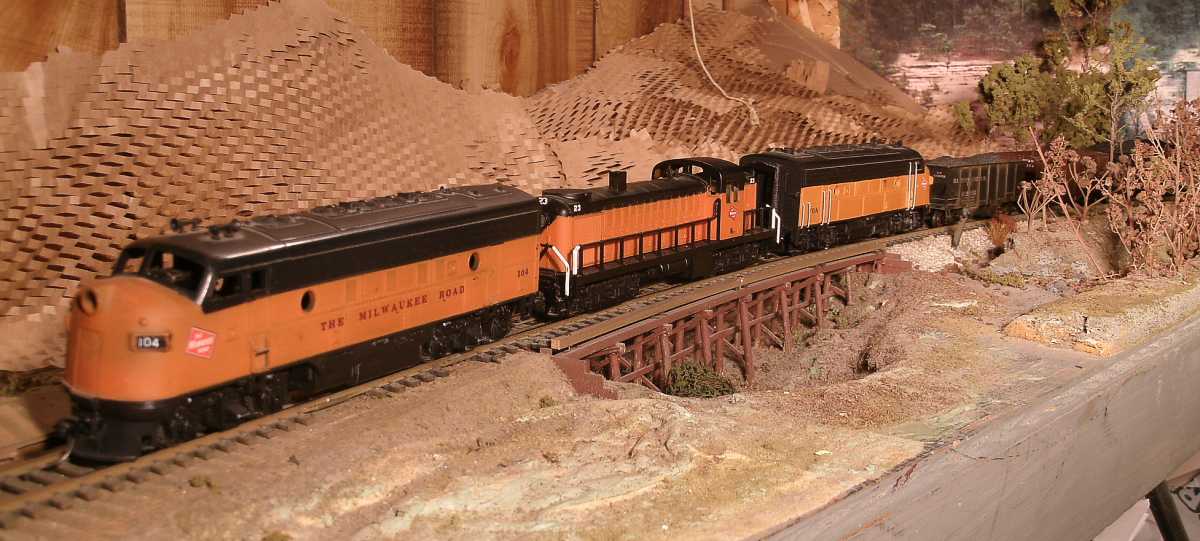
.
to My Main Index Page on the TrainWeb site.
This page was made in January and February 2023